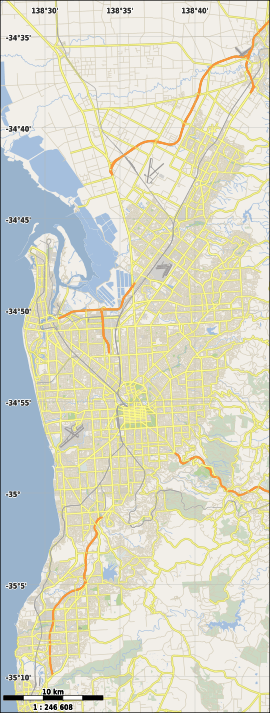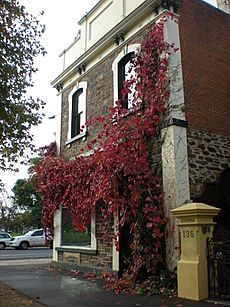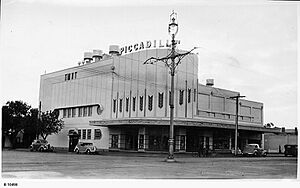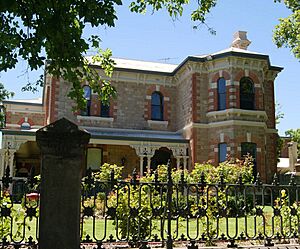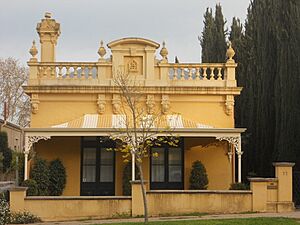North Adelaide facts for kids
Quick facts for kids North AdelaideAdelaide, South Australia |
|||||||||||||||
|---|---|---|---|---|---|---|---|---|---|---|---|---|---|---|---|
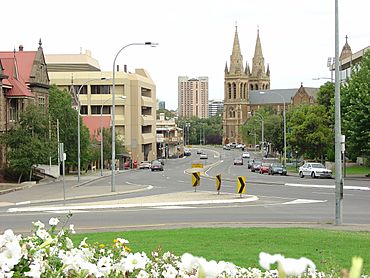
North Adelaide looking south down King William Road to St Peter's Cathedral and the City
|
|||||||||||||||
| Established | 1837 | ||||||||||||||
| Postcode(s) | 5006 | ||||||||||||||
| LGA(s) | City of Adelaide | ||||||||||||||
| State electorate(s) | Adelaide | ||||||||||||||
| Federal Division(s) | Adelaide | ||||||||||||||
|
|||||||||||||||
|
|||||||||||||||
North Adelaide is a suburb in South Australia. It's just north of the River Torrens and is part of the Adelaide Park Lands. Colonel William Light designed it in 1837. He planned it with a grid layout. This area has many beautiful old houses.
Contents
North Adelaide's History

Colonel William Light was the Surveyor-General. He finished planning the city of Adelaide by March 10, 1837. His plan included North Adelaide. This part was north of the River Torrens. That land became what we now call North Adelaide.
North Adelaide is famous for being the birthplace of two important people. William Lawrence Bragg (1890–1971) won a Nobel Prize for Physics in 1915. Emily Dorothea Pavy (1885–1967) was a teacher, researcher, and lawyer.
Kumanka Boys' Hostel
The Kumanka Boys' Hostel was at 206 Childers Terrace. The South Australian Government ran it from 1946 to 1980. In 1948, 23 boys aged 13 to 18 lived there. It was for boys who needed a safe place to stay. This included boys who had been at the Magill Boys' Reformatory.
H. A. Lyndon was the leader, and his wife was the matron. The hostel helped boys learn skills for life. They could leave and return with permission. They paid for their stay based on their wages. They were also encouraged to save money. Boys were expected to go to church. They were also encouraged to do activities and volunteer. The hostel had a workshop, a piano, sports gear, and a library.
A famous resident was Kaurna elder Uncle Lewis O'Brien. He remembered his time there fondly. He said the Lyndons were "excellent people." They helped him get his education. The house is a double-storey bluestone building from 1870. It is still standing today. It was added to the South Australian Heritage Register in 2001.
Historic Buildings and Places
North Adelaide has many buildings listed for their history. These are called heritage-listed buildings. One example is the North Adelaide Post Office. Another is "Sunnyside" at 229 Stanley Street. Architect F. Kenneth Milne designed it in 1936. It won an award for its design in 1944.
North Adelaide's Design

North Adelaide is made up of three main areas. These areas are designed to fit the land. The suburb is surrounded by parklands. These parklands have gardens and sports fields. The Adelaide Park Lands in North Adelaide include the Adelaide Oval. They also have a golf course. Some areas are kept natural, like they were long ago.
The largest area has Wellington Square in the middle. O'Connell Street is the main shopping street. It connects to King William Road. This road links North Adelaide to the main street of Adelaide City. A tram used to run along O'Connell Street. The government is thinking about bringing the tram back. O'Connell Street has many cafes, restaurants, and shops. It also has six pubs.
Lincoln College (University of Adelaide) and Aquinas College are also in this area. These are places where university students can live. Tynte Street is another busy street. It has the North Adelaide Primary School. There is also a public library and a post office. Radio stations Mix 102.3 and Cruise 1323 have their studios here.
The smallest area is bordered by Brougham Place and Pennington Road. It also has Sir Edwin Smith Avenue and Palmer Place. This area has the Women's and Children's Hospital. The Memorial Hospital is also here. You can find St Peter's Cathedral and St. Mark's College. The Cathedral Hotel is popular with cricket fans. The Queen's Head hotel is the oldest pub in Adelaide.
The third area is called Lower North Adelaide. It is closer to the River Torrens. This area has Brougham Place Uniting Church and St. Ann's College. It also has four pubs. Melbourne Street is its main street. It has cafes, restaurants, art galleries, and shops.
Fun Things to Do
Places to Eat and Drink
O'Connell Street and Melbourne Street are well known for their many restaurants. You can find all kinds of food there. Many pubs and hotels in North Adelaide are heritage-listed. In 2021, there were 11 pubs open in the suburb.
Some pubs are in upper North Adelaide. These include the Caledonian, Royal Oak, Oxford, and Archer hotels. The Wellington is on Wellington Square. In lower North Adelaide, you'll find the Lion Hotel, the Kentish Arms, Lord Melbourne, and The British. The Queen's Head Hotel and the Cathedral Hotel are near the cathedral.
Piccadilly Cinema
The Piccadilly Cinema is a movie theatre. It is on the corner of O'Connell Street and Childers Street. It was built in 1940. It has a special Art Deco style. This building is also heritage-listed. The name "Piccadilly" was chosen because of a town in the Adelaide Hills. It also relates to Piccadilly Circus in London.
After the original owner passed away, Greater Union bought the cinema. They changed its name to The Forum. In 1983, Wallis Cinemas bought it. They wanted to save it from being torn down. They changed its name back to Piccadilly. In the 1990s, Wallis turned the large cinema into a multiplex. This means it now has three screens.
The cinema closed for 18 months for a big renovation. It cost about $2 million. It reopened on December 15, 2022. The inside of the theatres was updated. A lift was added. A new lounge for food and drinks was also created. This lounge replaced old shops on O'Connell Street.
Education in North Adelaide
The North Adelaide Primary School is on Tynte Street. It opened in 1877. It is one of the oldest schools in South Australia. In 2007, about 250 students attended. The school's motto is "Esse quam videri." This means "To be, rather than to seem." The school colors are red and blue.
Queen's College (1885–1949) was a private boys' school. It was on Barton Terrace. It was the longest-running private boys' college in Australia. Another old private school was North Adelaide Grammar School.
Many colleges for university students are in North Adelaide. These colleges are linked to the University of Adelaide. They include Aquinas College and Lincoln College. Also, there are St. Ann's College and St. Mark's College. Kathleen Lumley College is for postgraduate students. The Australian Lutheran College is also here. It is a college for the Lutheran church.
Getting Around North Adelaide
North Adelaide has good roads for cars. However, during busy times, some roads get crowded. O'Connell Street and Melbourne Street can be very busy.
The North Adelaide railway station is on the Gawler line. This is part of the Adelaide rail network. The station is on the western edge of North Adelaide. Trains don't come very often, so it's not used much.
Several Adelaide Metro bus routes serve the area. Buses travel along different roads. These include King William Road, O'Connell Street, and Melbourne Street. Some of these routes used to be for electric trams.
Since 2014, there has been a free loop bus. It goes through Adelaide and North Adelaide. This bus is run by the Adelaide City Council and the state government.
North Adelaide is also good for bicycles. There are special paths on LeFevre Terrace and Frome Road. Many streets have little traffic, making them safe for bikes.
People of North Adelaide
In the 2021 Australian census, North Adelaide had 6,823 people. There were 1,494 families living there. About 58.9% of the people had a university education. More young adults (20-29 years old) live here compared to the rest of South Australia.
In the 2016 Australian census, there were 6,950 people in North Adelaide.
Types of Homes
There were 2,659 homes in North Adelaide. About 43.6% were semi-detached houses. These are houses joined to another house. About 28.7% were flats or apartments. And 26.4% were separate houses. The average home size is 1.9 people. This is smaller than the South Australian average of 2.4 people. Many of the buildings in the area are old and historic.


